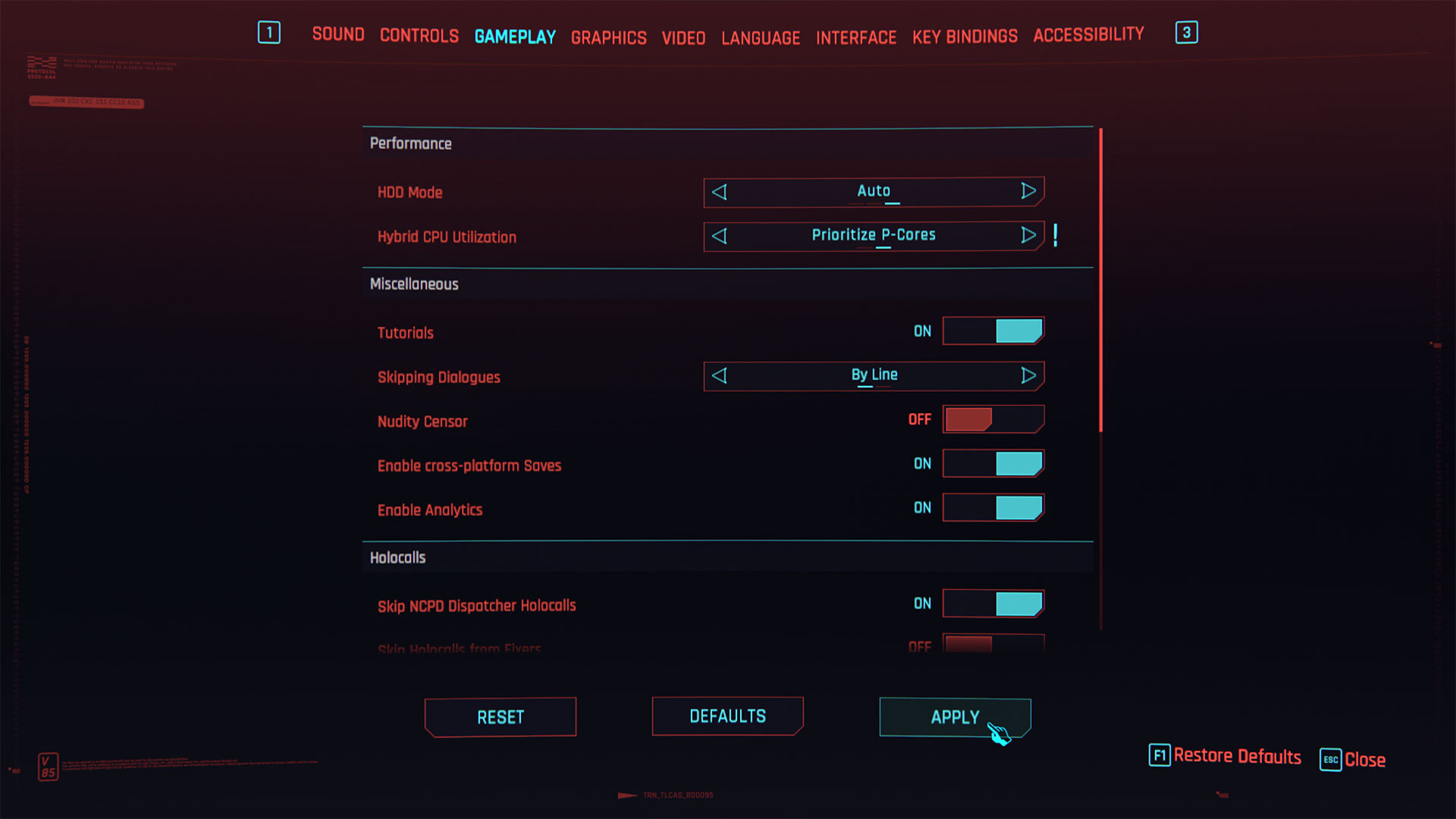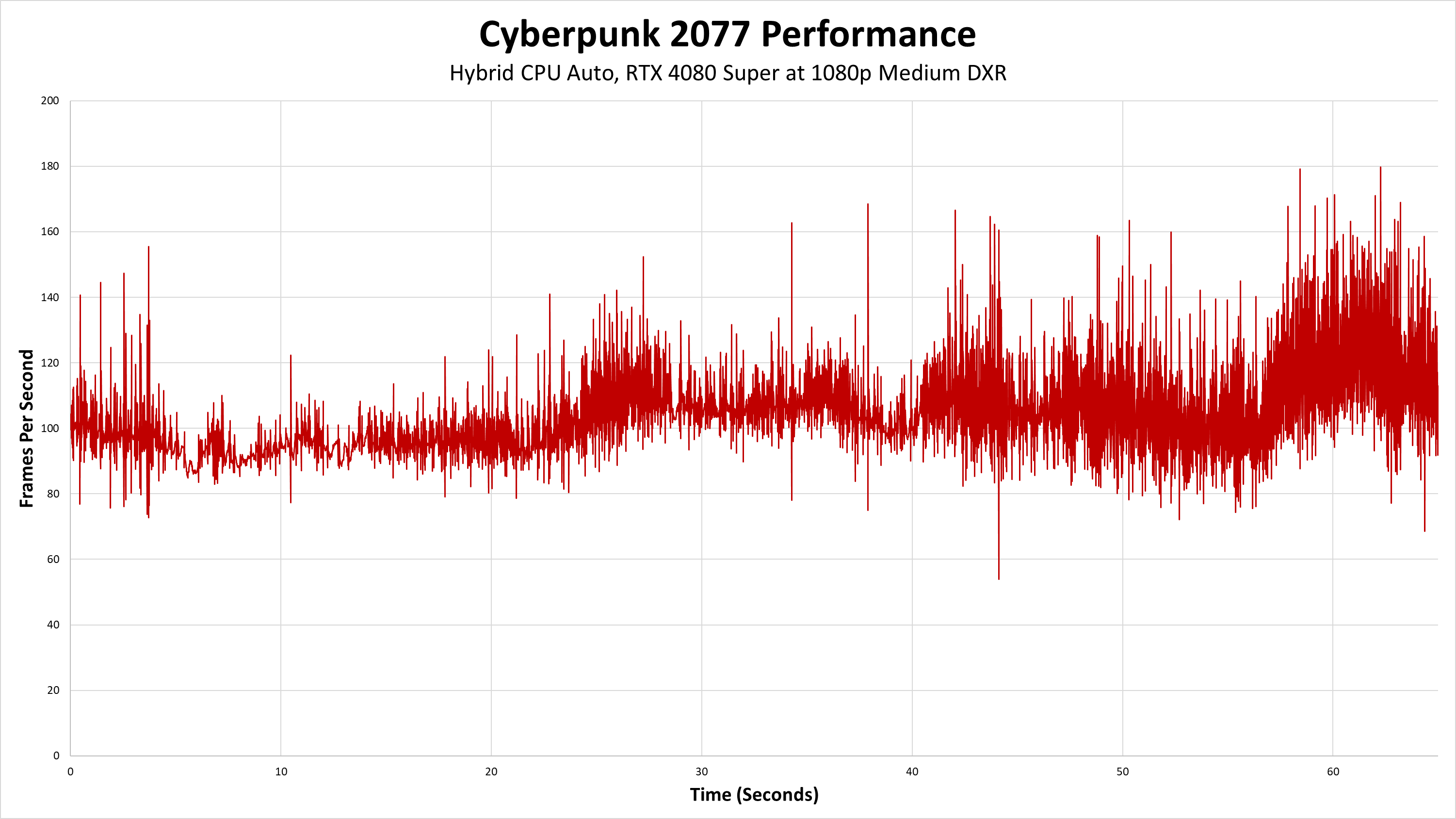Cyberpunk 2077 adds core prioritization for hybrid CPUs, which would be great if it didn't cause other problems (Updated)
It could help fix gaming issues with hybrid CPUs in the future.

Cyberpunk 2077 is now the first game that can prioritize P-Cores in hybrid CPUs to boost FPS and iron out performance problems. The new feature arrived in patch 2.11 and can be found in the game's gameplay sub-menu.
The new CPU optimization feature overrides Windows' core scheduler, forcing Cyberpunk 2077 to run on the CPU's performance cores — no matter what. We took the new feature for a spin, but we ran into some performance problems. We weren't the only ones. Now, a new patch 2.12 has cleaned things up and appears to be working properly.
The new feature is called Hybrid CPU Utilization and it has two modes. One is the automatic setting that allows the OS to do all the heavy lifting, while the other is called "Prioritize P-Cores" and it forces the game to run on the P-Cores only.
The idea behind this new setting is smart, and should — in theory — resolve scheduling issues that some users might have with the game. Improper core utilization on chips with performance and efficiency cores can cause major performance issues in CPU-bound games if the game is accidentally run on the CPU's E-Cores (which are, in most cases, much slower than its P-Cores).
Performance issues with Windows' scheduler aren't very widespread, but it isn't perfect. There are times when tasks will get loaded onto the wrong cores — even on Intel's hybrid CPUs, which come with Thread Director. Having a manual override in-game can potentially fix this problem without the user needing to jump through hoops and do things like disable the E-Cores in BIOS.




Cyberpunk 2077's initial implementation of the Hybrid CPU Utilization setting was not great. We tested it using a Raptor Lake i9-13900K and an Nvidia RTX 4080 Super, running the game on medium settings with DXR ray tracing enabled, and found serious micro-stuttering problems when the feature was turned on. The performance disparity was so great it was clear there was something wrong.
The 2.11 patch notes state that CD Projekt Red worked with Intel to sort out the stuttering problems, and we tested it and found things were now behaving properly. And by "behaving properly" we mean there was no serious loss in performance, but there was also no noteworthy gain in performance either.
We hadn't personally noticed any serious issues with Cyberpunk 2077's CPU utilization in the past, but if you have experienced problems and are using an Intel 12th, 13th, or 14th Gen CPU with a hybrid architecture — P-cores and E-cores — the new feature my help out. That doesn't mean all games should follow the same approach, as there are conceivably games where scheduling certain tasks on the E-cores makes sense. But having better tools to deal with hybrid CPU architectures could become increasingly important in the future.
Note: This article was originally posted on January 31, 2024, after the 2.11 patch came out. We have updated the text as of March 1, 2024, now that the 2.12 patch has fixed the problems noted in our original report.
Get Tom's Hardware's best news and in-depth reviews, straight to your inbox.

Aaron Klotz is a contributing writer for Tom’s Hardware, covering news related to computer hardware such as CPUs, and graphics cards.
-
usertests I wonder if it does anything at all for AMD's version of hybrid. For, example, 8500G/7545U/8540U with 2x Zen 4 cores, 4x Zen 4c cores. And more importantly, 4+8 Strix Point later.Reply -
Replyusertests said:I wonder if it does anything at all for AMD's version of hybrid. For, example, 8500G/7545U/8540U with 2x Zen 4 cores, 4x Zen 4c cores. And more importantly, 4+8 Strix Point later.
Nope, it won't make any difference nor will it work on AMD's hybrid CPUs either, because the Zen 4 and 4c cores don't behave in the same way like Intel's P and E cores. P and E cores are based on different architectures.
You guys must already be aware by now that ZEN 4c cores instead feature an identical IPC to "Zen 4," as well as an identical ISA. So, that's the same execution and issue width, the same number of registers, the same internal latencies, including multi-threading.
"Zen 4c" CPU core is just a compacted version of the "Zen 4" core without the subtraction of any hardware components, but rather a high density arrangement of them, which are generally clocked lower than "Zen 4" cores, as they can operate at lower core voltages.
BTW, it appears that there's much more asymmetry between Intel's core types, like differences in issue width, latencies and even instruction set. And more importantly, Intel's Efficient cores do not support multi-threading.
So there seems to be some complication to manage thread allocation and load balancing on Intel's hybrid design. -
thestryker Reply
They have half the L3 cache per core of Zen 4, otherwise yes.Metal Messiah. said:"Zen 4c" CPU core is just a compacted version of the "Zen 4" core without the subtraction of any hardware components, but rather a high density arrangement of them, which are generally clocked lower than "Zen 4" cores, as they can operate at lower core voltages. -
abufrejoval My understanding of the C cores in the Zen APUs is that they really aim to fill niches that are Wattage constrained anyway. So if only have 15 Watts available, the fact that each non-C core might reach top clocks never really matters, because all clocks will have to go down to what the condensed layout of the C's supports when they have to share meager single digit wattage per core.Reply
Yes, half the cache remains as a factor, but I don't think games will start to optimize for the cache size of each core type and count permutation in the market.
In short: any attempt of a game (or app) to treat Zen 4 C cores differently from Zen 4 W cores would be counter-productive. It's that simplicity AMD is selling and you'd disprove them if you'd gain noticeable performancne gains. -
Alvar "Miles" Udell Intel's hybrid system didn't make sense to begin with since the P and E cores aren't the same (different supported instructions and so forth) and weren't simply just lower performance/power efficient versions of the P cores, and even then it doesn't make much sense besides what can be achieved with just software limiting the speeds and voltages for battery life or uncapping them when connected to AC. We see this in practice where the 13900HX/14900HX (8P+16E) effectively score the same or even fall behind the 7945HX (16P) in multi-core tests despite having more processing cores.Reply
It is Intel's Bulldozer experiment, which failed and hopefully will be soon abandoned. -
magbarn Reply
Intel's going all in with their mobile chips even getting a set of 3rd class CPUs in Meteor Lake. Apple does fine with MacOS with hybrid cores. Is it Microsoft's fault that Windows is horrible at managing a heterogenous core?Alvar Miles Udell said:Intel's hybrid system didn't make sense to begin with since the P and E cores aren't the same (different supported instructions and so forth) and weren't simply just lower performance/power efficient versions of the P cores, and even then it doesn't make much sense besides what can be achieved with just software limiting the speeds and voltages for battery life or uncapping them when connected to AC. We see this in practice where the 13900HX/14900HX (8P+16E) effectively score the same or even fall behind the 7945HX (16P) in multi-core tests despite having more processing cores.
It is Intel's Bulldozer experiment, which failed and hopefully will be soon abandoned. -
Dorkasaurus_rex As someone who helped work to bring this patch to the game due to my ongoing issues with crashes on Cyberpunk 2077 with an i9-13900k, allow me to explain:Reply
Many, many modern games, including Returnal, Remnant from the Ashes 2, and a slew of other modern games, do not know how to schedule and prioritize the workload effectively across P and E cores. You will get either random crashes or error notifications about a "lack of video memory," even while running a 4090.
These crashes are very unfortunate, and the fix remains constant across all these games, including Cyberpunk 2077: A manual downclock of about 200-300mhz across all P cores done through Intel Extreme Tuning Utility (Intel XTU).
Now, with these fixes in place, this enables users to play the game with the full processing power of their 12th, 13th, and 14th gen processors, without thermal throttling, poor performance, crashes, and without having to run an entire separate program just to downclock their CPUs.
If it introduced stuttering, that is unfortunate, but Cyberpunk deserves credit for being the only game so far to even acknowledge this widespread problem exists, let alone implement an actual solution to fix it. I am sure further tuning and tweaking will be needed to prevent micro stuttering other users are claiming to have since patch 2.11, but simply turning off the Hybrid CPU Utilization option, or leaving it to "auto" should restore behavior and performance to how it was in the prior patch.
If you just do a brief Google search for "i9 13900k out of video memory," you can find many, many such users across MANY modern games with this exact same problem, being resolved in this exact same way.
Again, the Cyberpunk team deserves credit for not only acknowledging this issue exists, but actually implementing a fix, even if it's imperfect. -
TerryLaze Reply
It makes perfect sense if you think like a company for a second, why would you put more than 8 very expensive cores in a CPU if you can instead fill it up with cheapo cores?Alvar Miles Udell said:Intel's hybrid system didn't make sense to begin with since the P and E cores aren't the same (different supported instructions and so forth) and weren't simply just lower performance/power efficient versions of the P cores, and even then it doesn't make much sense besides what can be achieved with just software limiting the speeds and voltages for battery life or uncapping them when connected to AC. We see this in practice where the 13900HX/14900HX (8P+16E) effectively score the same or even fall behind the 7945HX (16P) in multi-core tests despite having more processing cores.
It is Intel's Bulldozer experiment, which failed and hopefully will be soon abandoned.
When all cores are working they all have to power down and clock lower so why not have your standard 8 cores and the rest can be cheap cores that always perform as if the whole CPU where under full load, because that's the only time they would do any work anyway. (as far as benchmarks are concerned anyway)
That is what AMD discovered now as well, after a few years of watching intel doing it and thought hey, why aren't we doing that as well, and hey presto c versions, because they can't afford a completely new design.